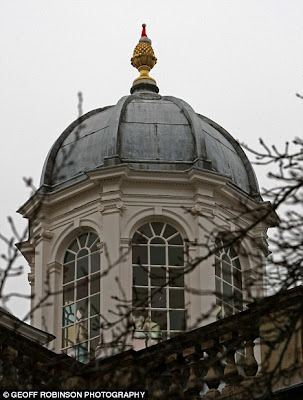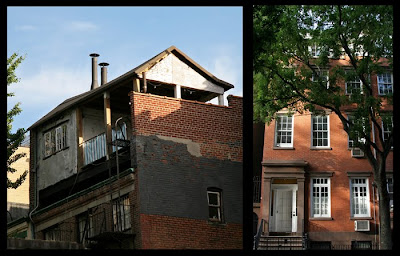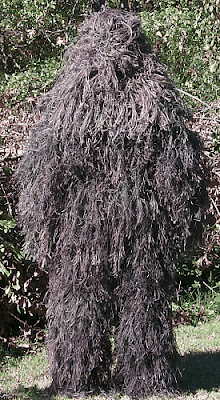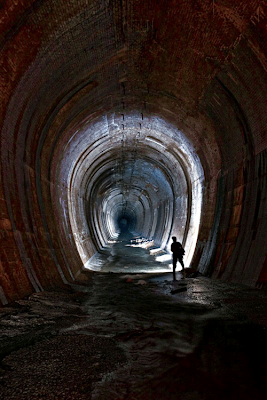Thursday, January 1, 2015
Poisonous Pea Soup
You all know how fond I am of New York. I don't think I've ever written about my obsession with London. I adore big, sprawling cities that make little sense to outsiders. (Tokyo shares similar charms.) While I appreciate the formal beauty of towns such as Paris, I prefer chaos. I want to be surprised, shocked, or titillated every time I take a turn. London delivers. It's a big, beautiful mess. I wouldn't want to live there, but it's a city I'll never get tired of visiting.
And, of course, London's long history puts New York's four hundred years to shame. I could write a thousand posts on the strange events that have taken place in London, the bizarre figures who have called it home, and the fabulous fictional characters the city has produced over the last thousand years. (This blog is named Bank St. Irregular for a reason.)
But today, I'll focus on pea soup fogs. Like most Americans of my generation (and possibly yours), I always romanticized the fogs that once descended on London. They called to mind natty trench coats and Sherlock Holmes tales. (Not to mention Jack the Ripper.) Of course the London fogs were anything but romantic. "Pea-soupers" were a direct product of pollution. That picturesque fog was poison, and every time it rolled into town thousands of people perished.
The pea-souper of December, 1952 may have killed more than twelve thousand people. (To put that into perspective, it's almost four times the number of people who died here in New York on 9/11.) Fortunately, those deaths led to legislation that eventually cleared the skies over London.
Check out the wonderful Nickle in the Machine blog for more pictures of the 1952 killer fog. I love it when another blog does my work for me (and does a much better job than I would have done).
The Night Climbers of Cambridge


Last week, three fire engines were dispatched to Cambridge University in Britain. The firemen had been called by university officials and asked to perform a rather unusual task. A student hoaxster had placed red Santa's hats on the spires of two tall buildings, and the humorless university officials wanted the hats removed. (Read a news report here.)
That's not the interesting part. The question is: How did the hats get up there in the first place? As you can see from the photos above, the hoaxster didn't choose the most accessible rooftops.
That's why some are suggesting that the hoaxster must have made use of a book known as The Night Climbers of Cambridge. Written by the mysterious "Whipplesnaith" and published in 1937, the tome offers a guide to exploring the roofs of the city's ancient buildings. It even offers handy tips on how to get around chimneys, pillars, and gargoyles.
I love the idea of students slinking through the night, hopping from rooftop to rooftop with their trusty guide tucked into their back pockets. On the awesome meter, The Night Climbers ranks right up there with Glimpses of Gotham and the Perforating Mexicans. (Below: One of the many amazing photographs from the book.)

Want even more awesome? (I can barely take it!) You can read the entire book here.
The Color That Keeps the Ghosts Away

I love knowing the crazy origins of everyday things. Take, for example, the blue shown above. You see this and similar "watery" hues throughout the Southern US. "Haint Blues," as they're called, are used to paint ceilings, shutters, and sometimes even entire buildings. They're lovely, of course, but they serve a surprising purpose.
Here's the story, via the wonderful blog Curious Expeditions . . .
Known as the Gullah or Geechee people, the original Haint Blue creators were descendants of African slaves who worked on rice plantations in South Carolina and Georgia. . . . They are well-known for preserving their African heritage more than any other African American community. They kept alive the traditions, stories, and beliefs of their ancestors, including a fear of haints.
Haints, or haunts, are spirits trapped between the world of the living and the world of the dead. These are not your quiet, floaty, sorrowful ghosts, they are the kind you don’t want to mess with, and the kind you certainly don’t want invading into your humble abode looking for revenge. Luckily, the Gullah people remembered an important footnote to the haint legend. These angry spirits have a kryptonite; they cannot cross water. The safest place would be in an underwater bubble, or perhaps to surround your house with a moat. But the Gullah people had a much more elegant solution. They would dig a pit in the ground, fill it with lime, milk, and whatever pigments they could find, stir it all together, and paint the mixture around every opening into their homes. The haints, confused by these watery pigments, are tricked into thinking they can’t enter.
Awesome! Read more here.
Fake Houses Are Everywhere

(Above: Can you spot the fake house?)
I can't believe I've never posted on this subject. It's one that's fascinated me for quite some time.
The fact is, if you live in a major metropolitan area, there's a good chance that at least one of the houses you regularly pass on the street isn't quite . . . real.
Take, for example, 23/24 Leinster Gardens in London (shown above). It looks like a house. It has columns and balconies and plants growing in the boxes out front. But the whole thing's just for show. The house that once stood on the site was torn down in the 19th century to make way for a subway line. To keep the neighbors happy, a facade was built to hide the gaping hole and open train tracks that replaced the lovely dwelling.

But unless you took a very close look, you'd probably never know the difference! (Want to know more? Check out the whole story and more pictures here.)
But enough with London. Recently, I was thrilled to learn that there's a brownstone in Brooklyn that hides a secret entrance to/exit from the New York subway system. And only the NYPD knows where it is! According to the Associated Press . . .
The NYPD allowed the AP to visit the hidden exit — fronted by the phony house in a quiet residential neighborhood — on the condition that its origins and location not be disclosed. The department also barred photos.
Located in the tunnel just east of the river, the exit leads to a grimy lit set of metal stairs that ascend past utility boxes and ventilation shafts into a bleak, windowless room with a door. Anyone opening the door would find themselves on a stoop — part of the facade replicating a town house.
The passageway once was secured from the outside only by a giant bolt in the middle of the door that was opened with a tire iron. It's now rigged with silent alarms and motion detectors that would alert police to an intruder.
Awesome. I believe it is my duty as a citizen of Brooklyn to discover the location of this house and use the entrance to begin my subterranean life of crime. (Kidding!) If any of you find it first, send me a picture! I promise I won't tell a soul.
(Oh, and I know for a fact that it's not the only dummy house in NYC. So even if you spend your days in one of the four other boroughs, you should still keep an eye out!)
Pretty Deadly
(Above: Don't get any closer.)
I have a strange relationship with plants. I adore them, but they seem to die in my presence. (Although I do have a Chia Pet that's doing quite well at the moment.) I've always wondered if there might be something about me that's toxic to plants.
If so, I share that trait with the daffodil, which may be my favorite flower. They're springing up all over Brooklyn right now. (Brooklyn in the spring is unbelievably beautiful.) They seem so sweet and innocent--but each and every one of them is a potential serial killer. Put a daffodil (or any member of the Narcissus genus) into a vase with other flowers, and the daffodil will release a poisonous sap that will kill the other flowers. Pretty nasty, right?
According to Wikipedia, "daffodil itch" is the bane of many florists. The toxic sap causes "dryness, fissures, scaling, and erythema in the hands, often accompanied by subungual hyperkeratosis (thickening of the skin beneath the nails)." I have no idea what some of that means, but ewww.
The leaves and bulbs of daffodils contain a poison called lycorine, which can cause all sorts of foul symptoms. (I'd give you the list, but it's rather disgusting.) Yeah, but who would eat a daffodil, you ask? Well like any successful serial killer, it knows how to lure its victims. Because daffodil bulbs resemble onions, they have a tendency to end up in soups and stews. As you might suspect, schoolchildren are the daffodil's favorite prey.
Do You Hear Voices?

(Art by Joanna Hellgren. Based on the Henry James novella, The Turn of the Screw. If you haven't read it, do.)
Here's the most interesting fact I've come across in a while. According to a new study, "nearly 1 in 10 seven- to eight-year-olds hears voices that aren't really there."
You can read more here. The article is careful to point out that most kids who hear voices don't find them troubling. And the vast majority will never develop any mental illness.
But why would we assume something might be wrong with the kids? What if the voices they're hearing are real? And if they are real--what are they?
Searching for Monstrous Swine in Hampstead's Sewers

(Above: On the hunt for sewer pigs?)
We all know that New York's sewers are home to alligators. (Oh, you didn't know that? Well then scroll down a few posts.) But back in the 1850s, the sewers of Hampstead (then north of London, now part of the city) were said to house ferocious feral pigs.
According to Henry Mayhew's book, London Labour and the London Poor (which is, believe it or not, one of the most fascinating books ever written) . . .
There is a strange tale in existence among the sewer-workers, of a race of wild hogs inhabiting the sewers in the neighborhood of Hampstead. The story runs, that a sow in young, by some accident got down the sewer through an opening, and, wandering away from the spot, littered and reared her offspring in the drain, feeding on the offal and garbage washed into it continuously. Here, it is alleged, the breed multiplied exceedingly, and have become almost as ferocious as they are numerous.
Mayhew didn't believe the stories, but plenty of people did. You can read more about the origins of the tales here!
And if you're looking for a little light reading that will leave you nice and nauseous, I recommend this article on London's early sewers.
Water Hazard
I once knew a guy who had a rather unusual way of making a few extra bucks. He and a friend would sneak onto golf courses under cover of night and collect the golf balls that had been lost in the water hazards. They made quite a bit of money selling the balls they recovered. And while their activities weren't strictly legal, I always thought they deserved every penny. After all, no one else was going to do it. Why? My acquaintance lived in southern Louisiana, and the water hazards he frequented were all filled with alligators.
I used to think it would be great fun to play golf on an alligator-filled course. But now I have a new goal. I want to visit the Carbrook Golf Club in Brisbane, Australia. It may be the only golf course in the world where the water hazards are infested with . . . SHARKS. Seems a nearby river flooded several years ago, and six large bull sharks made their way into a lake in the middle of the course. They're all still there. And they're breeding.
Bull sharks have been known to nibble a human now and then. (You can't really hold it against them.) And golfers are known to be particularly delicious. So if any of you are up for the challenge, I bet that lake is filled with a fortune in golf balls.
More here.
This One's For All the New Yorkers Out There

(Photo from New York Daily Photo.)
If you live in New York, you know there's nothing more magical than a rooftop house. They're incredibly hard to spot. Some can only be seen from certain angles. Others can only be spotted if you're flying over the city in a helicopter. So when you happen see one, it's a very special occasion.
Last summer, I was taking some kids on tour of Greenwich Village, when I happened to spot something unexpected. A building on MacDougal Street had been torn down, revealing a temporary glimpse of an unusual rooftop structure that had been hidden from view for almost one hundred years. (See above.) I later learned that the little house was known as Alchemist's Corner--a name given to it by one of it's previous tenants, the famous actor John Barrymore. (Read more here.)
A gallery of other rooftop houses can be seen here. One of the featured buildings was the inspiration for Kiki Strike's rooftop digs!
Every Girl Needs a . . . Ghillie Suit

Observing wildlife? Hunting Bigfoot? Spying on the neighbors? Looking for something to wear to your wicked stepsister's wedding? Then you need your own ghillie suit!
(From Wikipedia: A ghillie suit is a type of camouflage clothing designed to resemble heavy foliage. Even more interesting, a "Ghillie Dhu"--which means "dark servant" in Gaelic--is a type of woodland faerie that's said to be kind to children. Thought you should know.)
Fortunately, this site offers handy tips for making your own ghillie. Pretty awesome!
Fresh Stone Age Meat

I try to avoid the world of advertising on this blog. But I doubt any of you are in the market for a European refrigeration system, so I figured I'd go ahead and share a clever ad with you.
The Bosch company wanted to show just how long its cooling technology kept food fresh, so they decided to "sell" Stone Age meat. They wrapped up "dinosaur legs" and "saber-tooth fillets," and placed them in the meat aisles of supermarkets for people to discover. (Though I doubt dinosaurs were around in the Stone Age, but we won't get too nit-picky here.)
I think it would be rather fun to find something like that while browsing the ground chuck. I wonder if anyone tried to buy it.
I Hope I Look This Good When I'm Seven Hundred Years Old
I wish I lived in a part of the world where well preserved 700-year-old mummies are lying beneath the streets, just waiting to be discovered.
The tomb of the lady shown above was found in the Chinese city of Taizhou. Experts say the woman's dress dates from the Ming Dynasty, which means she lived sometime between 1368 and 1644. Judging by her jewelry and the possessions discovered inside the tomb, she was also a woman of means. (Love that ring.)
No one knows much about the secret methods that were used to produce Chinese mummies. But it's pretty clear that they were nothing like those employed in Egypt. Many of the best preserved Chinese mummies have been found submerged in a rather nasty-looking liquid.
More here.
Two New Underground Cities to Report

(Awesome picture from agentsofurbanism.com.)
It seems that some states are luckier than others when it comes to secret underground cities. I recently discovered that Kansas has not one but TWO!
The first can be found under the sleepy town of Leavenworth. The article I read doesn't offer much information, but from what I gather, a stretch of underground storefronts can be accessed through the basement of a tile company. Though the tunnels are clearly old, no one can agree on why they were built--or who might have built them. Some say they were created to hide fugitive slaves, others think they were used to run liquor during prohibition. In either case, I wish I could find some better pictures!
The second underground city is beneath Ellinwood, Kansas. Actually, it's more of an underground village, since it now consists of two long tunnels and three rooms built sometime in the 1850s. (Apparently it was once much bigger.) You can find an interesting guide with pictures here.
So our list of American Shadow Cities grows! Here are the ones I've discovered so far . . .
Portland
Seattle
Pendelton, OR
Fresno
Chicago
Leavenworth, KS
Ellinwood, KS
Tacoma, WA
New York (of course!)
Am I missing any? (Of course the list of international Shadow Cities is much longer. I just found out that Beijing has one, too! More on that later.)
The Child Vampire Hunters of Scotland

I've been writing this blog for four years now, and I've come across some pretty weird stuff. But this is one of the strangest stories I've ever heard.
In 1954, a rumor was making its way through the primary schools of Glasgow, Scotland. A seven-foot vampire with iron teeth had made a graveyard just south of the city his home. And he'd already dined on two little boys.
Rumors about vampires are pretty common in primary schools. (At least in MY experience.) But the kids of Glasgow took such things very seriously. On the night of September 23, 1954, four hundred of them armed themselves with steak knives and sharpened sticks and went to the cemetery in search of the vampire.
They found the police instead. (Forget vampires, the scariest thing most adults can imagine is a mob of knife-wielding fourth graders.) The authorities tried to convince the children that the vampire couldn't possibly be real. But the kids knew better. Night after night, they returned to the graveyard as soon as the sun had set, intent on protecting their city from a blood-sucking fiend.
The incident led to a crackdown on American horror comic books. But a new documentary suggests that the rumors had a much different source. (Pay close attention, Japanese parents!)
Check out the whole story at the BBC.
You Need to Know: How to Escape from Zip Ties
Okay, this is awesome. Truly amazing.
Your odds of being nabbed by a bad guy (of whatever variety) are pretty slim. However, if you find yourself in the middle of a kidnapping/hostage situation/mafia war, there's a pretty good chance that you'll end up bound with zip ties. They're easier, cheaper, and lighter than rope or duct tape. And most bad guys assume the ties make escape impossible. They're wrong.
The genius who stars in the videos below looks like a pretty big dude. So if (like me) you're a smaller, less muscular member of our species, I recommend practicing the techniques a bit. (Once the first video ends, be sure to click on the others offered.)
Your odds of being nabbed by a bad guy (of whatever variety) are pretty slim. However, if you find yourself in the middle of a kidnapping/hostage situation/mafia war, there's a pretty good chance that you'll end up bound with zip ties. They're easier, cheaper, and lighter than rope or duct tape. And most bad guys assume the ties make escape impossible. They're wrong.
The genius who stars in the videos below looks like a pretty big dude. So if (like me) you're a smaller, less muscular member of our species, I recommend practicing the techniques a bit. (Once the first video ends, be sure to click on the others offered.)
Subscribe to:
Posts (Atom)




